Flowers That Die but Revive Again
1 / 11
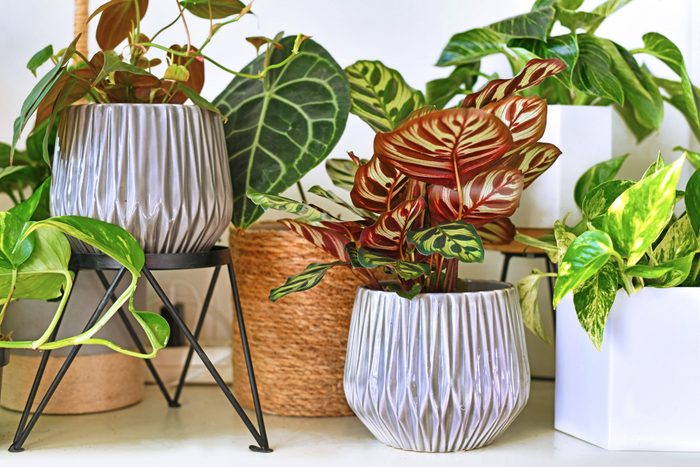
All may not be lost!
If you're hither, chances are you've got a expressionless found on your hands. Don't exist too difficult on yourself—it happens to the best of united states and sometimes even with the most depression-maintenance plants. But we've got some skillful news for you: Your sad-looking establish may be only mostly dead, to borrow a line from The Princess Bride, and y'all might really exist able to revive it. "Some of the most common reasons for a plant to deteriorate are overwatering or underwatering, not getting the correct amount of dominicus, changes to their environment, bugs and pests, or nutrient deficiencies," says gardening good John Valentino, owner of John & Bob'due south Smart Soil Solutions. "All of these problems can be fixed, as long every bit you lot notice them in fourth dimension."
Of class, nosotros're hither to tell you lot exactly how to do that. From identifying even the virtually subtle signs of life to correcting the mistakes you lot've made, these unproblematic steps volition assistance you return your plant to its quondam glory and help you reap the wellness benefits of gardening. Once you're a plant pro, yous might desire to peruse the all-time places to buy plants online and option up a few of the best indoor plants—or maybe these bogus plants that no one will be able to tell are simulated.
2 / 11
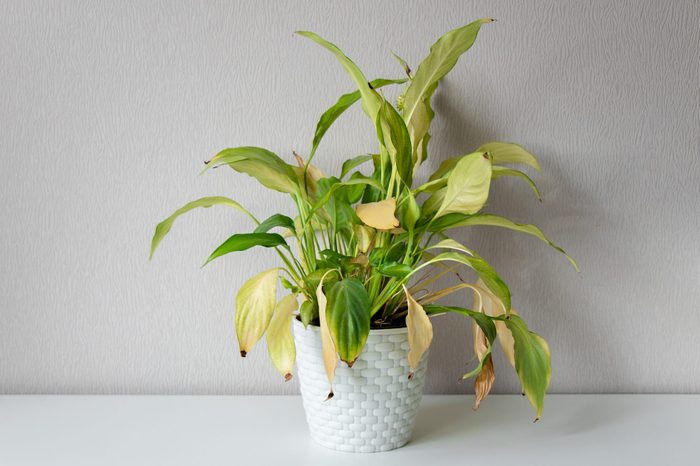
Pace one: Look for signs of life
When information technology comes to plants, "dead" is a relative term. It may await like your found is a goner, but when you take a closer look, that may not actually be the case. If at that place'south any green left on the institute, you might still be in business. "Whatsoever signs of light-green on the stem hateful in that location's a chance you'll be able to bring it back to life," says Valentino.
Y'all should also bank check the roots. As the institute's back up system, they provide a lot of information nigh the state of its overall wellness. Translation: Fifty-fifty if the visible parts of the plant are a mess, the roots may nonetheless be receiving enough nutrients and h2o to proceed it going. "Healthy roots should appear plump and be white to tan in colour with white tips," says Jennifer Morganthaler, an agriculture teacher at Missouri Country University. "The roots should all the same exist alive and have a chance to recover for whatever of these tips to work to save the plant." If you lot do find signs of life, the next step is figuring out what went wrong and how to revive your plant.
RELATED: Air-Purifying Plants for Your Home
three / 11
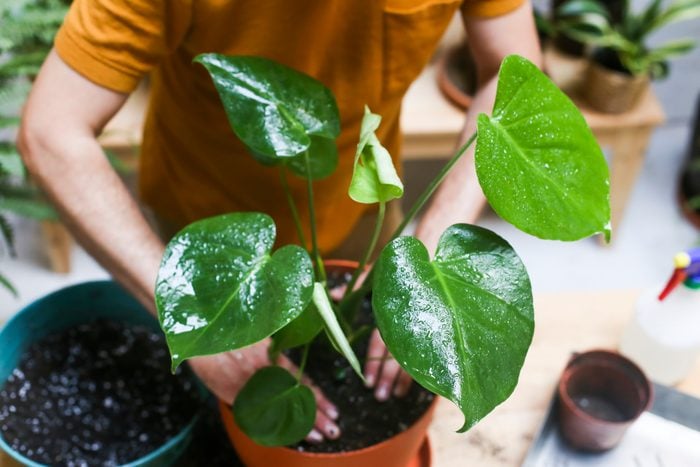
Step 2: Check if yous've overwatered
Plants need water to survive and thrive, but it'south possible to give a plant too much water. How tin can yous tell? "Overwatered plants volition have brown or xanthous wilted leaves with moist soil," says Valentino. "This will affect the roots, which tin can start to rot." If you've been giving your found too much water, you volition need to brand some changes—ASAP. "Motion the institute out of straight sunlight and stop watering until the soil dries out," advises Morganthaler. "If the soil is soggy, yous may want to change the soil and the pot." From there, do a little research. Await up your plant and its watering preferences, and make sure to follow that information to a T in the future.
4 / xi
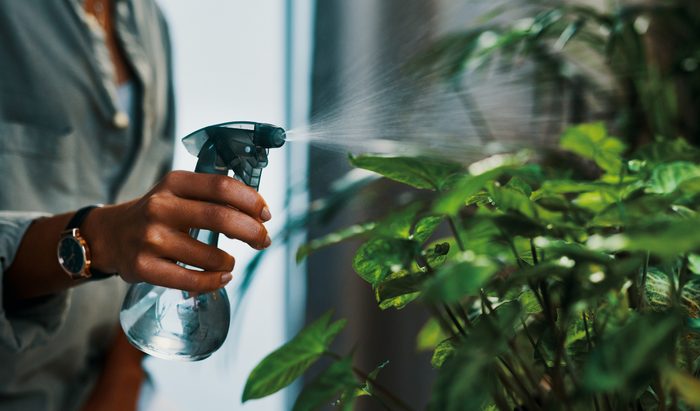
Step iii: Check if yous've underwatered
Only like overwatering, it's also easy to underwater—and for many people, a likely scenario. What are the signs of a thirsty found? "The plant volition begin to wilt," notes Morganthaler. "Leaves volition first to dry and brownish at the tips, and then turn brownish, die, and drop off. The soil will also cleft and pull abroad from the edges of the pot."
Of course, h2o is the answer here, but y'all have to go about watering a dying constitute in the correct way. "If a constitute has been severely underwatered, a quick way to revive it is to let it soak in water for a few hours," says Vickie Christensen, master gardener and plant doctor at Léon & George. "Many plants go from droopy and sad to cute, lush, and perky in just one 24-hour interval with this method!"
From there, it'southward all about regular TLC. "Water more often, and give the plant the same corporeality of water each time," Morganthaler advises. "Make sure to give the water time to soak down to the roots." A soil moisture meter tin can assist you monitor the soil's moisture—and brand sure y'all're on the correct runway for your specific institute.
RELATED: Indoor Hanging Plants That Will Liven Up Your Home
five / 11
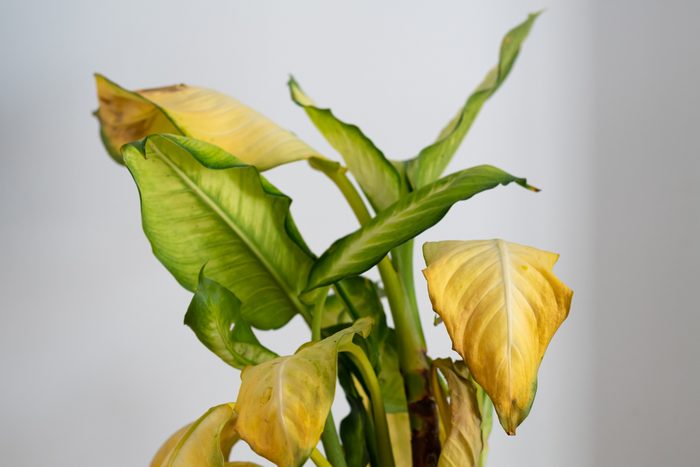
Step iv: Remove dead leaves
Plants that are deteriorating will probable have dead leaves, and you'll demand to get rid of them. Be ruthless: If leaves are completely brown, they're non coming back; y'all want to focus on new growth instead. To remove them, snip the dead leaves with a pair of plant shears or scissors, or gently pinch the expressionless leaves with your fingertips. Typically, expressionless leaves will come off the stalk easily, only if you have to tug, employ a pair of shears.
half dozen / 11
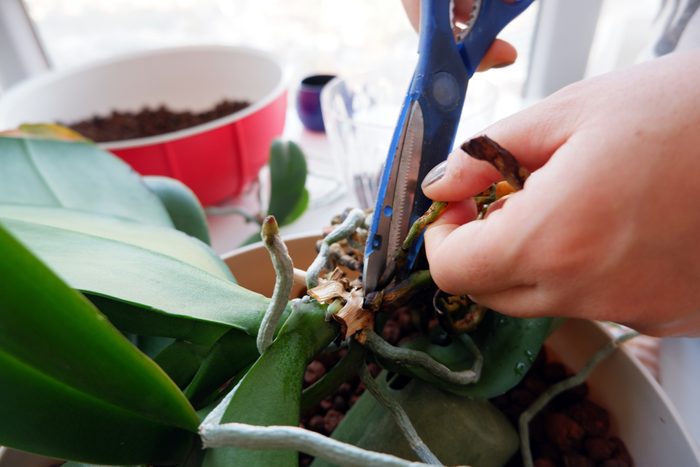
Stride five: Trim dorsum the stems
Of course, green is good. Anything else? Not then much. To that cease, you'll want to trim stems dorsum to just the green tissue. "Trim dorsum the dead leaves, and and then take off dead bits of the stem as well," says Valentino. "Ideally, y'all want to take it all the way dorsum to the healthiest bits of the establish, but if the stems are dead, then get out at least ii inches of them above the soil."
This is too a practiced time to change the soil—and even the pot. Morganthaler recommends repotting the plant in a larger container or pot at this time. And exist warned: Y'all likely won't see a change for the amend right away. Depending on the plant, it could take a few weeks or longer till the constitute is in a improve state of health.
RELATED: 15 Toxic Plants You May Already Have at Home
seven / eleven

Pace 6: Look at the lighting
Let in that location be calorie-free—or maybe not so much of information technology! Lighting is an important factor for the health of your houseplants, so you'll need to make certain that your variety is getting the optimal amount. Once yous know if your houseplant prefers total sun, partial sun, straight sunlight, or indirect sunlight, then y'all can move information technology to a more suitable area of your home. "If your plant isn't getting enough low-cal, moving information technology to somewhere information technology volition can help," says Christensen. Depending on its country, a seemingly dead establish might perk upwards sooner rather than later with just this simple tweak. Don't have a lot of light in your domicile? Consider these low-low-cal houseplants that thrive in near darkness.
8 / xi
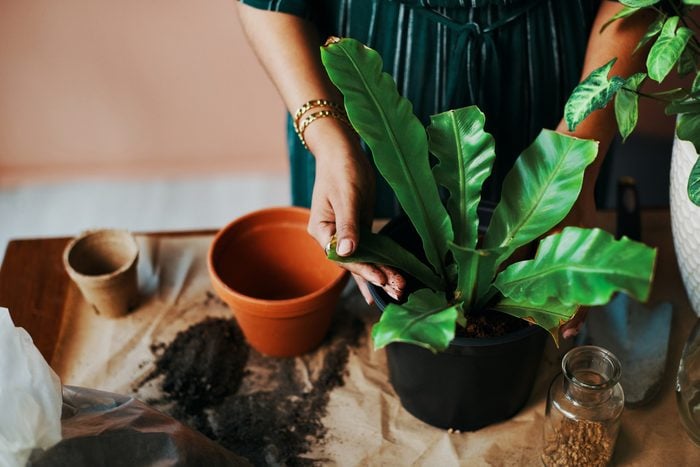
Step vii: Determine if your plant needs more humidity
If your plant came from the tropics, it may be dying to get back to that type of environment—literally. Although the amount of humidity depends on the institute, at that place are some indicators that a plant may need more moisture in the air. "If the humidity is too low," says Morganthaler, "the plant can show signs of shriveling, browning, and wilting." If more humidity is needed, try misting your plants regularly or grouping them together to help increase humidity.
Of course, too much humidity will be a problem for some plants. "If the humidity is as well high, the plant can develop mold or mildew, fungal infections, and yellow leaves," says Morganthaler. In general, she notes, plants with thicker, waxier leaves tolerate dry air better, and that's the situation in almost of our homes. Nonetheless, Christensen adds, "while houseplants accept been acclimated for life indoors and don't necessarily need very boiling conditions, most won't like sitting side by side to a heater or air vent, as this can be too dry for their liking."
nine / eleven
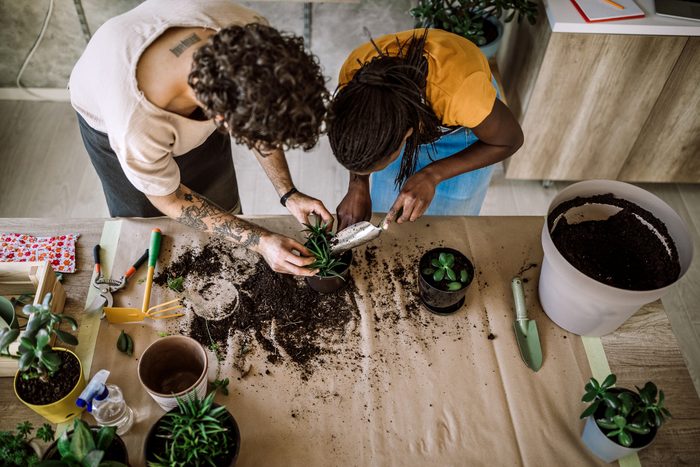
Step eight: Provide boosted nutrients
Feeding your institute is especially important during the growing seasons of spring and summer. A malnourished establish, says Valentino, will exhibit weak stems or discolored leaves, so to revive a dying constitute, you'll need compost or fertilizer. 2 adept options: Dr. Earth's liquid food, which contains simply organic ingredients and no synthetic chemicals, and the brand's all-purpose organic fertilizer for all types of plants. Merely repotting your dying plant can also assist. "Soil can become depleted of nutrients over time, and so repotting every few years is ever a good idea," says Christensen.
If, nevertheless, your plant is in bad shape, it's a proficient thought to starting time out slow. You don't want to make a number of sudden changes all at once since the found is probable to already be in a state of daze and more susceptible to bug. Over time, go along upwardly the good habits. "Nearly plants do all-time with a little fertilizer, usually once or twice a month, during the growing flavour," Christensen adds.
RELATED: The Best Fruit Trees You lot Can Grow Indoors
10 / xi
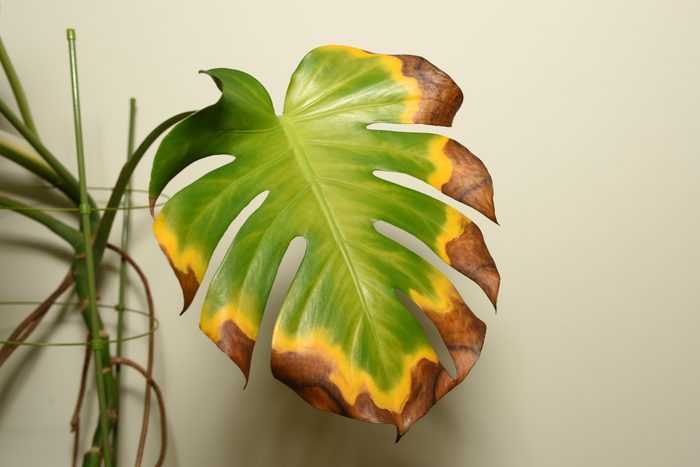
Pace 9: Await at least a month
Information technology can be easy to lose hope when it looks like your efforts aren't paying off. But remember: Information technology took a while to most kill your constitute, and it's going to take a while to nurse it back to health. The primal is to exist patient. Go along tending to your plant for a few weeks and and so reevaluate. "Once you've taken steps to revive a dying institute, it can accept upwardly to a calendar month before you start to see an comeback or new growth, then don't give up on it also presently," says Valentino. You may also need to exercise some troubleshooting before figuring out the exact problem and the subsequent solution, so the process may accept longer than expected. By the way, this is what your houseplants would tell you if they could.
11 / 11

Pace 10: Compost it
If y'all've tried everything, including waiting a minimum of a calendar month, and your plant hasn't fabricated any progress, information technology's possible that it'south time to say adieu. But instead of tossing your expressionless plant in the trash, place information technology in a compost bin. When you compost your plants, even if they're expressionless, the remains tin can be turned into nutrient-rich soil that acts every bit a natural fertilizer that can benefit your other houseplants or garden. That means your expressionless plant can have new life—and contribute to the health of your future plants while also helping the environment. Never tried your hand at compost? Hither's how to make compost at dwelling house. Information technology's easier than you recollect!
Next, bank check out these mosquito repellent plants you demand ASAP.
Sources:
- John Valentino, and owner of John & Bob'southward Smart Soil Solutions
- Jennifer Morganthaler, plant adept and agronomics teacher at Missouri Land Academy
- Vickie Christensen, Main Gardener & Plant Doctor at Léon & George
Originally Published: May 13, 2021
higginssirsenes1962.blogspot.com
Source: https://www.rd.com/list/how-to-revive-a-dead-plant/
0 Response to "Flowers That Die but Revive Again"
Post a Comment